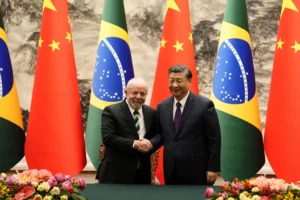Brazil has recently deepened its ties with China, guided by a multipolar world view.
This shift led President Lula to include the Chinese Army in Brazil’s military seminar, showcasing Brazil’s growing engagement with China.
Latin America is now a key focus for China, aiming to extend its reach in a region traditionally allied with the U.S.
This approach involves economic deals, but they raise concerns about debt and unfair trade.
Trade between Latin America and China has surged, growing 35% from 2000 to 2022, with a jump from $14 billion to $500 billion.

Peru is also moving closer to China, especially in terms of military cooperation.
A Chinese military team visited Lima, discussing joint exercises and training to boost their military bond.
Moreover, Peru has welcomed Chinese President Xi Jinping, signaling a strong partnership.
Contrasting Paths: China’s Growing Influence in Latin America
The $3.5 billion Chancay port project, led by Chinese firm Cosco Shipping, is a key example of this growing relationship.
In contrast, under President Javier Milei, Argentina is taking a different path.
Milei has rejected Chinese military gear, opting for American F-16 jets instead. He also refused to join the BRICS group, marking a notable shift in Argentina’s foreign policy.
Meanwhile, Brazil’s President Lula keeps embracing China. His visit to China focused on reducing the dollar’s dependence and promoting trade in other currencies.
This highlights Brazil’s openness to Chinese influence.
China’s involvement in Latin America is not without conditions. It seeks diplomatic isolation from Taiwan and support for its global human rights stance.
This approach shows China’s strategic intentions in the region.
China’s influence in Latin America spans commerce, geopolitics, and military aspects.
It’s become a major player in key sectors like lithium and telecommunications, which are crucial for regional trade and security.
To counter China’s influence, upholding democracy and greater involvement from Europe and the U.S. are seen as vital.
Lessons from African and Asian nations, often facing sovereignty and human rights challenges with China, serve as warnings for Latin American countries considering closer ties with China.

